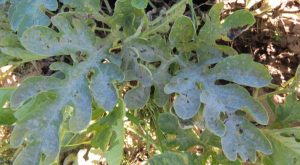Podosphaera xanthii

Watermelon leaf infected with powdery mildew. Image provided by Dr. Lina Quesada, NC State Vegetable Pathology Lab
Cucurbit powdery mildew is caused worldwide by the fungal pathogens Podosphaera xanthii and Golovinomyces cichoracearum. Podosphaera xanthii is more common¹ and, apparently, may be the only one on cucurbits in North America². Early symptoms of powdery mildew include small, circular, yellow lesions on leaves and petioles. Lesions quickly become covered in white spores and may appear also on the underside of the leaf. The pathogen may be entirely restricted to the undersides of leaves in areas with intense sunshine, e.g., Imperial Valley, California. As disease progresses the entire leaf and petiole surface may become covered in the characteristic white powdery powdery spores that may also be found on peduncles (stems) and fruit. Powdery mildew affects all cucurbit crops such as cucumber, melon, squash, and watermelon.
Diagnostic Resources
- MyIPM for Vegetables – An App developed by the Southeastern Vegetable Extension Workers
- Plant Disease Clinics
Plant Disease Management Reports
- Evaluation of watermelon cultivars for powdery mildew management, Goldsboro 2022. PDMR 17:V099
Rosado-Rivera Y.I., Quesada-Ocampo L.M.
Disease Control Information
- Resources for commercial growers: Cucurbit Powdery Mildew – McGrath Lab at Cornell’s Long Island Vegetables
- Vegetable Pathology Lab Factsheets – Quesada-Ocampo Lab at North Carolina State University
Cucurbit powdery mildew – NC State Vegetable Pathology Factsheets
Añublo polvoriento en cucurbitáceas – NC State Hoja informativa de patógenos de vegetales - UC Pest Management guidelines – State of California IPM program, 2016
- Watch for powdery mildew on vine crops – Michigan State University, 2014
